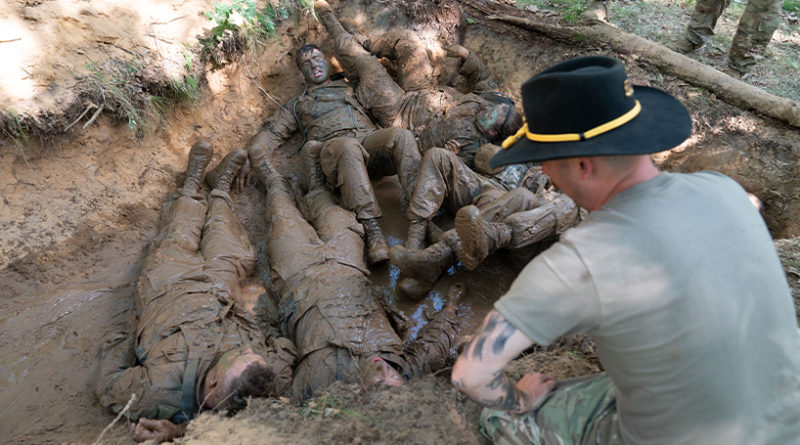Wisconsin cavalry unit’s Spur Ride blends tough training with unit history and tradition
By Maj. Brian Faltinson
Wisconsin Army National Guard cavalry troopers connected tough, mission-focused individual skill training with a celebration of cavalry tradition and the centennial celebration of a historic Wisconsin unit.
The Madison, Wisconsin-based 1st Squadron, 105th Cavalry celebrated its 100th anniversary and tested individual Soldier skills with a grueling Spur Ride held during its June annual training period at Fort McCoy.
A Spur Ride is series of training events focusing on individual skills vital for all cavalry Soldiers. Those who complete all tasks successfully receive a set of silver spurs that can be worn as part of the uniform during special squadron events.
“The Spur Ride draws from cavalry history when new unit members were assigned a horse and he rigorously trained in the disciplines of horsemanship and care for their animal,” said Lt. Col. Matthew McDonald, commander of 1st Squadron, 105th Cavalry, who as the new squadron commander was a Spur Ride participant. “When the rider demonstrated his proficiency to his unit, he earned spurs previously withheld due to novices’ habits of injuring their animals with spurs.”
Modern Spur Rides reinforce proficiency with land navigation, heavy weapons, first aid, and physical fitness. The 105th holds the event every few years and the specific slate of events is decided by those who have already earned their spurs. Even amidst the context of celebrating the unit’s centennial, the event helps build readiness for the unit’s current and future missions in support of its mission as a primary combat reserve of the United States Army.
“Spur holders strive to create conditions that physically and mentally replicate the incredible stresses of combat,” McDonald said. “Troopers are expected to navigate across significant distances under loaded packs and demonstrate their proficiency with weapons, communications gear, medical tasks, and scout observation tasks. The entire unit benefits from the opportunity to focus on core reconnaissance and Soldier tasks.”
Most of the Spur Riders are new to the unit, but not all are new soldiers.
“All ranks and all ages go through the Spur Ride,” said Staff Sgt. Keith Gillingham, a spur holder in the 105th. “The majority are brand new soldiers who want to show what they’re worth, but there are also Soldiers at all levels who transfer into the squadron all the way up to the squadron commander who’s doing the Spur Ride with us as well.”
Earning one’s spurs is a difficult task, and most do not succeed their first time through. Spc. Skylar Wall of Fort Atkinson’s Troop A narrowly missed out on his spurs two years ago, but that experience helped him prepare for this year’s slate of events.
“This is a great training experience, and I’ve tried to be more mentally and physically prepared for this time,” Wall said. “It’s meant to break you down mentally and physically, but your team is there to support you. It builds a lot of confidence within a soldier.”
The 105th Cavalry in Wisconsin dates to 1921, but Wisconsin’s cavalry history goes back even further. The unit honored that history by incorporating knowledge of unit and cavalry history into various Spur Ride training lanes.
“It’s a great opportunity to be in this organization with the 100 years and all the lineage and history that comes along with that,” said Command Sgt. Major Ryan Johnson, the 1st Squadron, 105th Cavalry’s senior enlisted Soldier. “To commemorate that with a spur ride is pretty special.”
The 105th’s cavalry roots date to 1880 when Milwaukee’s Light Horse Squadron organized to provide a mounted escort for prominent Civil War generals attending a national reunion of Civil War soldiers. It was the first Wisconsin National Guard unit reorganized after the Civil War. The Light Horse Association still exists today as an informal organization for Wisconsin cavalry troopers past and present.
The Light Horse Squadron eventually organized as Troop A, 1st Wisconsin Cavalry and it expanded into an entire cavalry regiment in 1917 when the U.S. entered World War I. Soon after, the War Department decided against sending horse cavalry to Europe and Wisconsin’s cavalryman served during the war as field artillery Soldiers with the 32nd “Red Arrow” Division.
Wisconsin’s desire to field a cavalry regiment remained after the war and a number of cities organized cavalry troops which were organized into the 105th Cavalry Regiment on April 1, 1921.
The 105th trained with horses in units stationed in Stanley, Milwaukee, Eau Claire, Watertown, Kenosha, and Fort Atkinson in the 1920s and 1930s and established itself as one the state’s top regiments. However, World War II permanently ended the days of horse cavalry and the 105th in 1940 converted into a number of field artillery and support units for service in World War II.
The Wisconsin National Guard fielded a number of mechanized cavalry units after the war but that number had declined to a single troop by the early 2000s. In 2007, the 32nd “Red Arrow” Infantry Brigade Combat reorganized to include the 1st Squadron, 105th Cavalry. With troops located in Madison, Fort Atkinson, Watertown, and Reedsburg, the new squadron has embraced Wisconsin’s proud cavalry history and continues the Light Horse Squadron’s legacy of service to both state and nation.
“Our Troops’ lineages include famous campaigns such as Second Battle of the Marne, Battle of Juvigny and Meuse-Argonne in World War I, and Papua New Guinea, Leyte, and Luzon in World War II,” said McDonald.
The unit and its 46 newest silver spur recipients closed annual training by joining the Light Horse Association for a formal 105th Cavalry centennial dinner for all Wisconsin cavalry troopers past and present. It was held at Watertown’s historic Turner Hall, which served in the 1920s and 1930s as the Troop K, 105th Cavalry armory.
Senior Airman Anya Hanson contributed to this report.

